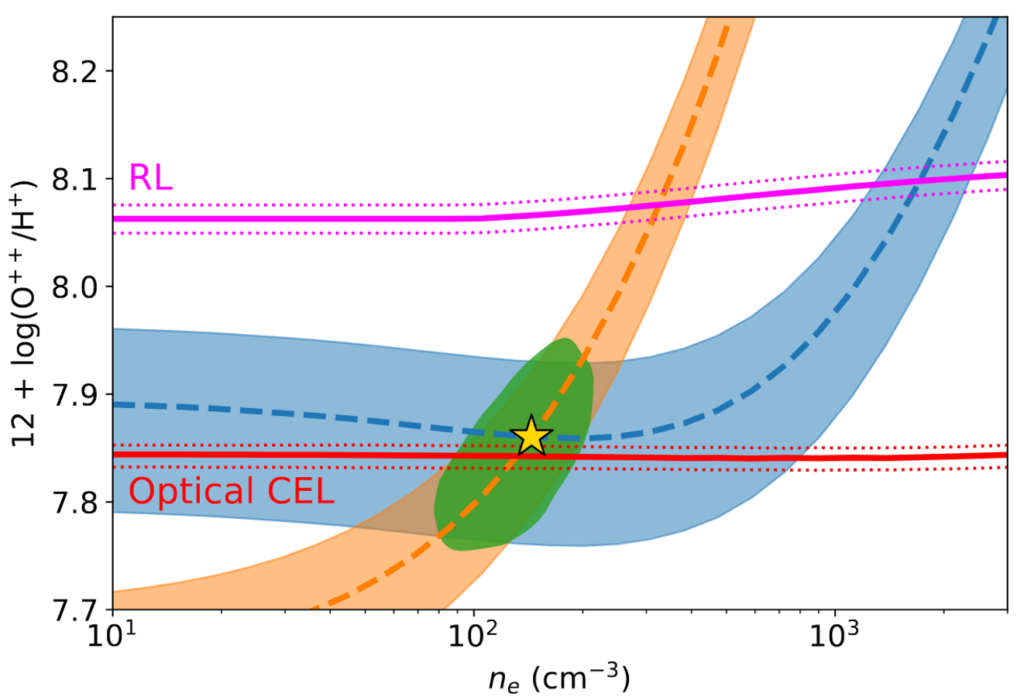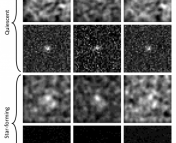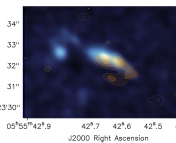Title: Accurate oxygen abundance of interstellar gas in Mrk 71 from optical and infrared spectra
Authors: Yuguang Chen, Tucker Jones, Ryan Sanders, Dario Fadda, Jessica Sutter, Robert Minchin, Erin Huntzinger, Peter Senchyna, Daniel Stark, Justin Spilker, Benjamin Weiner and Guido Roberts-Borsani
First Author’s Institution: Department of Physics & Astronomy, University of California
Status: Published in Nature Astronomy [open access]
When studying galaxies, some of the key properties that help astronomers understand the inner workings of these cosmic giants include their temperature, density, and metallicity. These properties can be used to unravel the history of star formation across the Universe. In particular, the metallicity (the amount of heavy elements relative to lighter elements) gives an indication of how stars are assembled within galaxies, how stars enrich their surroundings, and, in turn, how the surrounding environment impacts star formation. Unfortunately, accurately determining properties like the metallicity has proven to be quite the challenge (see this and this bite).
In today’s paper, astronomers have used a variety of instruments in order to accurately determine the metallicity of a nearby, giant star-forming region called Markarian 71 (Mrk 71) in the dwarf galaxy NGC 2366. In Figure 1, we show an image of this galaxy as captured by the Pan-STARRS telescope in Hawaii. The overlaid coloured boxes on this figure correspond to the fields-of-view of additional telescopes used here to study this region – yellow for the Herschel Space Observatory, blue for the Keck Observatory in Hawaii and magenta for the Stratospheric Observatory For Infrared Astronomy (see this bite for more information about SOFIA; the telescope on a plane). With such a wealthy dataset, there’s a lot that can be learnt about star formation within this region.

Why target Mrk 71?
This giant region of active star formation has a low mass, a low metal content, and is forming stars at a vigorously high rate. It is therefore considered to be an ‘extreme’ environment, but only in the local Universe. It makes for an interesting target because the aforementioned conditions within this region are actually pretty close to what we expect conditions were like in the very early Universe. For this reason, Mrk 71 is likely one of the nearest analogs to early star-forming galaxies.
Trying to determine the metallicity of early Universe galaxies has become more and more of a research focus following the launch of the James Webb Space Telescope (JWST; see this astrobite), but early galaxies are very distant, very faint and their environments are nothing like what we are used to working with. Testing the methods used to determine the metallicity on nearby targets with similar properties to early galaxies is therefore a key step towards understanding what’s going on in the distant past.
The discrepancy dilemma
So why is obtaining the metallicity of a region or galaxy so problematic? Well, one issue is that the metallicity of star-forming regions is dependent on many properties, such as the temperature, density, and ionisation of the gas. The temperature and the metallicity are, in particular, strongly correlated. The lower the metallicity, the hotter the gas. One of the preferred methods to determine the metallicity is the temperature-based (or ‘direct’) method (labelled CEL in Figure 2), where the temperature of the gas is first determined and this strong correlation is then used to find the metallicity. Another favoured method is the recombination line method (labelled RL in Figure 2) – here, special emission lines (peaks in the spectra of a region) are used to determine the abundance of a heavier element (e.g., oxygen) relative to a lighter element (e.g., hydrogen). This method is largely independent of the temperature, but there is some dependence on the density.
These two methods should agree – theoretically, they both trace the same metal content of a region, but using a different approach. Instead, to the frustration of many, these methods consistently fail to produce the same metallicity across pretty much all regions and galaxies. This well-known dilemma is known as the Abundance Discrepancy Problem, and remains an unsolved puzzle in astrophysics to this day. For Mrk 71, we can see in Figure 2 that the CEL and RL values differ by around 0.2 dex (roughly a factor of 1.5).

An oft-proposed explanation for this discrepancy dilemma is that there may be temperature fluctuations across the region, which would make the temperature-based CEL value an underestimate of the true metallicity. With the wealthy dataset of this region, this hypothesis can be tested further.
The other end of the spectrum
A third method to determine the metallicity, and to test this hypothesis, takes us all the way to the far-infrared (FIR) side of the spectrum. FIR emission lines are largely independent of the temperature, just like the RL method. For this method, FIR oxygen emission lines are compared to optical hydrogen emission lines to determine the metallicity. If temperature fluctuations are really causing the Abundance Discrepancy Problem, then the value obtained via this method should be very similar to the RL value, since they are both practically insensitive to temperature fluctuations. However, as we can see by the yellow star and green shaded area in Figure 2, the combined optical and FIR value is very close to the temperature-based CEL value – i.e., the discrepancy can not be caused by temperature fluctuations!
The authors of today’s paper suggest that it is perhaps fluctuations in the density that cause the RL value to overestimate the true abundance, meaning that the CEL and combined optical and FIR values are closer to the true metallicity. This has important implications for the future of star formation studies across cosmic time.
One exciting possibility that this research opens up is the use of the most powerful telescope on the ground, ALMA (to capture the FIR emission), combined with the most powerful telescope in space, JWST (to capture the optical emission), in order to accurately determine the metallicity with the combined optical and FIR method for very early, very distant galaxies, with potentially less observational time needed than for the direct CEL and RL methods.
Astrobite edited by Keighley Rockcliffe
Featured image credit: Laurent Drissen, Jean-Rene Roy and Carmelle Robert (Department de Physique and Observatoire du mont Megantic, Universite Laval) and NASA/ESA




